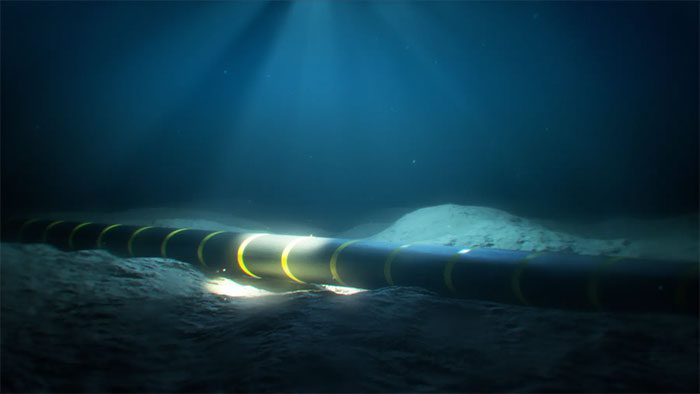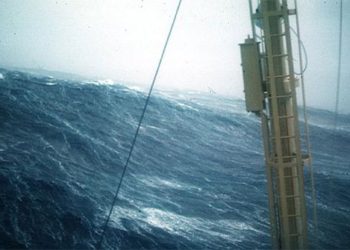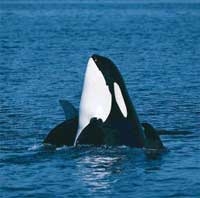“Underwater avalanches” are powerful natural events that frequently occur beneath the surface of the ocean.
It is important to understand that “underwater avalanches” are not snow avalanches but rather sediment landslides under the ocean, resembling the scale and nature of snow avalanches on land. However, these phenomena are invisible to us and extremely difficult to measure. Consequently, we know very little about how underwater avalanches operate.
Threats to Global Information Systems
These phenomena pose dangers to global communication networks. The expansion of the internet requires an increasingly extensive network of undersea fiber optic cables that can transmit nearly all global internet traffic.
A recent study by Christopher Stevenson, a Senior Lecturer in Quantitative Sedimentology at the University of Liverpool, regarding an ancient underwater landslide has shed light on this phenomenon and may change how geologists assess their potential risks.
It is estimated that there are currently more than 550 operational undersea cable routes worldwide, totaling 1.4 million kilometers — enough to circle the Earth’s equator 35 times.
When an “underwater avalanche” severs an undersea cable, the consequences can be widespread and costly. The 2006 earthquake in Hualien, Taiwan triggered underwater landslides that cut off several undersea cables connecting Southeast Asia to the rest of the world.

The frequency of avalanche occurrences depends on location.
At the peak of the incident, the largest internet service provider in China reported a 90% loss of traffic to the U.S., and Taiwan itself experienced a loss of between 74-100% of internet traffic to neighboring islands.
This disrupted the global market as the volume of financial transactions plummeted due to technical issues. Repairs to restore the network to maximum capacity took up to 39 days and cost millions of USD.
The aforementioned landslide moved sediments at speeds of up to 72 km/h. However, this is relatively small compared to some of the massive underwater avalanches that have occurred in the Atlantic Ocean.
The good news is that there are many undersea cable routes, so an underwater avalanche cannot completely collapse the internet worldwide. Even if main routes are severed, there are still a few alternative paths available. However, the speed of transmission will be severely reduced.
Searching for Supermassive Underwater Avalanches
In a recent research paper, Stevenson and his colleagues mapped the devastation of a supermassive underwater avalanche that occurred 60,000 years ago off the coast of Morocco.
This avalanche traveled over 400 km through the largest submarine canyon in the world and an additional 1,600 km across the Atlantic Ocean floor. It is the second largest underwater avalanche ever recorded in historical data.
Stevenson’s team mapped the landslide by combining detailed bathymetric maps and hundreds of sediment cores, analyzing the sediments from the landslide over a vast area. In each core, they analyzed deposits for fossils, determining that the event occurred 60,000 years ago.
The 60,000-year-old avalanche contained enough sediment to fill 140,000 Wembley Stadiums (162 km³). It was as tall as a skyscraper (over 200 meters), moved at a speed of at least 54 km/h, creating a trench 30 meters deep and 15 km wide over a distance of 400 km (comparable to the distance from London to Liverpool), destroying everything in its path.
Subsequently, it spread over an area the size of Germany, burying itself under one meter of sand and mud. Such scale is not seen in land-based avalanches.
However, the team realized that the underwater avalanche actually began as a small landslide, then grew over 100 times along its path. In comparison, the maximum growth of underwater avalanches is much greater than that of land-based avalanches (which typically increase in size by only four to eight times). This challenges scientists’ common view that large underwater avalanches start when steep slopes collapse.
Preventing this Terrifying Phenomenon
From this, we now know that underwater avalanches can begin small and grow along their path into catastrophic events. Therefore, these new insights could change how we assess the potential risks of “avalanches” under the ocean, focusing more on the path of the “avalanche” rather than just identifying the initial landslide area.
The frequency of these events depends on location. Submarine canyons near river mouths with large rainfall basins are often more prone to small “avalanches.” Systems further away from river mouths, like the Agadir Canyon off northwestern Morocco, experience a major “avalanche” only once every 10,000 years.
There are many potential triggers for “underwater avalanches” such as earthquakes, tides, storms, river flooding, and even volcanic eruptions. Notably, climate change will likely cause some of these triggers to occur more frequently and intensely.
However, these triggers do not guarantee that an “avalanche” will occur, nor are they related to the scale of the event. For example, in 1755, a massive earthquake struck the coast of Portugal, destroying much of Lisbon and killing tens of thousands of people. Yet, it only caused a small underwater “avalanche.”
In contrast, in 1929, a major earthquake off the coast of Newfoundland, Canada, triggered the largest underwater “avalanche” ever recorded.
Stevenson and his colleagues used detailed seabed surveys and sediment cores to recreate the characteristics of this event. They determined that the “avalanche” moved at a speed of 68 km/h, carrying a dense mix of boulders, sand, and mud, and severed 11 undersea cables on its descent.
The “avalanche” in Canada was so large that it generated a tsunami, killing 28 people along the coast. This remains the first and only massive underwater “avalanche” directly measured by severed cables.
Our understanding of “underwater avalanches” is still in its infancy. Research continues to provide new insights into where “avalanches” occur, how they operate, and how to measure their intensity and devastation. These significant events serve as a reminder of the many wonders still hidden beneath the deep sea.





















































